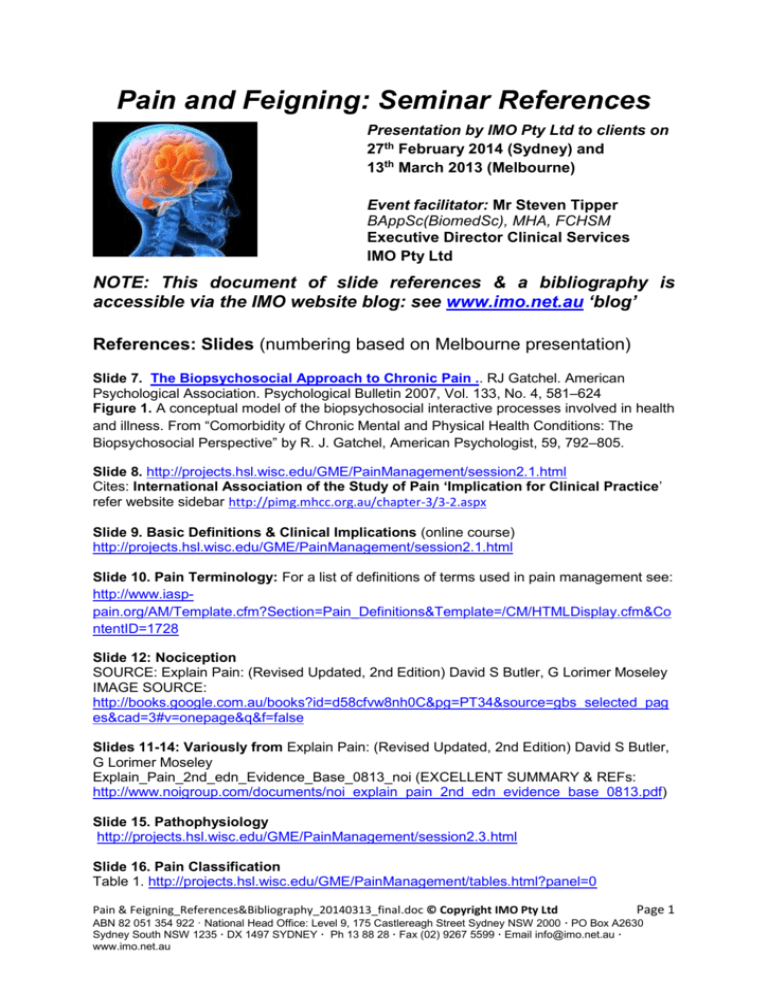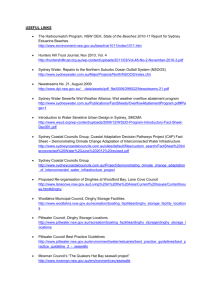Assessment and Treatment of Chronic Pain
advertisement

Pain and Feigning: Seminar References Presentation by IMO Pty Ltd to clients on 27th February 2014 (Sydney) and 13th March 2013 (Melbourne) Event facilitator: Mr Steven Tipper BAppSc(BiomedSc), MHA, FCHSM Executive Director Clinical Services IMO Pty Ltd NOTE: This document of slide references & a bibliography is accessible via the IMO website blog: see www.imo.net.au ‘blog’ References: Slides (numbering based on Melbourne presentation) Slide 7. The Biopsychosocial Approach to Chronic Pain .. RJ Gatchel. American Psychological Association. Psychological Bulletin 2007, Vol. 133, No. 4, 581–624 Figure 1. A conceptual model of the biopsychosocial interactive processes involved in health and illness. From “Comorbidity of Chronic Mental and Physical Health Conditions: The Biopsychosocial Perspective” by R. J. Gatchel, American Psychologist, 59, 792–805. Slide 8. http://projects.hsl.wisc.edu/GME/PainManagement/session2.1.html Cites: International Association of the Study of Pain ‘Implication for Clinical Practice’ refer website sidebar http://pimg.mhcc.org.au/chapter-3/3-2.aspx Slide 9. Basic Definitions & Clinical Implications (online course) http://projects.hsl.wisc.edu/GME/PainManagement/session2.1.html Slide 10. Pain Terminology: For a list of definitions of terms used in pain management see: http://www.iasppain.org/AM/Template.cfm?Section=Pain_Definitions&Template=/CM/HTMLDisplay.cfm&Co ntentID=1728 Slide 12: Nociception SOURCE: Explain Pain: (Revised Updated, 2nd Edition) David S Butler, G Lorimer Moseley IMAGE SOURCE: http://books.google.com.au/books?id=d58cfvw8nh0C&pg=PT34&source=gbs_selected_pag es&cad=3#v=onepage&q&f=false Slides 11-14: Variously from Explain Pain: (Revised Updated, 2nd Edition) David S Butler, G Lorimer Moseley Explain_Pain_2nd_edn_Evidence_Base_0813_noi (EXCELLENT SUMMARY & REFs: http://www.noigroup.com/documents/noi_explain_pain_2nd_edn_evidence_base_0813.pdf) Slide 15. Pathophysiology http://projects.hsl.wisc.edu/GME/PainManagement/session2.3.html Slide 16. Pain Classification Table 1. http://projects.hsl.wisc.edu/GME/PainManagement/tables.html?panel=0 Pain & Feigning_References&Bibliography_20140313_final.doc © Copyright IMO Pty Ltd Page 1 ABN 82 051 354 922 · National Head Office: Level 9, 175 Castlereagh Street Sydney NSW 2000 · PO Box A2630 Sydney South NSW 1235 · DX 1497 SYDNEY · Ph 13 88 28 · Fax (02) 9267 5599 · Email info@imo.net.au · www.imo.net.au Slide 17. Neuropathic Pan EXPLAIN PAIN – SECOND EDITION David S. Butler and G. Lorimer Moseley Slide 18. Neuropathic pain syndromes An Update on Neuropathic Pain Stefanie Rehm, Jana Koroschetz, Ralf Baron European Neurological Review, 2008;3(1):125-127 http://www.touchneurology.com/articles/update-neuropathic-pain Slide 19. Neuropathic pain assessment Neuropathic Pain Assessment – An Overview of Existing Guidelines and Discussion Points for the Future Nurcan Üçeyler, Claudia Sommer European Neurological Review, 2011;6(2):128131 Slide 20. 1 in 4 GP patients has chronic pain Catherine Hanrahan Medical Observer 6th Aug 2013 Source1: http://www.medicalobserver.com.au/news/one-in-four-gp-patients-has-chronic-pain CITES: Pain Medicine 2013; online 15 July NOTES: GP Pain Help App: The Australian College of Rural and Remote Medicine (ACRRM) and the Centre for Palliative Care Research and Education (CPCRE) have jointly developed a free app and website for GPs to help better manage patients in pain at or near the end of their lives. The app includes a treatment decision tree, a section on types of pain and various analgesics, breakthrough pain information, a dose conversion tool, patient FAQs, pain management and palliative care resources and a troubleshooting section. The content has been developed by the Centre for Palliative Care Research and Education (CPCRE) and the app and website by the Australian College of Rural and Remote Medicine. Source2.: http://www.pulseitmagazine.com.au/index.php?option=com_content&view=article&id=1672:app-tohelp-gps-help-patients-in-pain&catid=16:australian-ehealth&Itemid=328 GP Pain App Resource (download): http://www.gppainhelp.com/Title.html Slide 21-23. Phases of pain treatment Assessment and Treatment of Chronic Pain - A physician’s guide to a biopsychosocial approach. By John Mark Disorbio, EdD, Daniel Bruns, PsyD and Giancarlo Barolat, MD http://www.practicalpainmanagement.com/treatments/psychological/assessment-treatmentchronic-pain Slide 25. Malingering pain in a medico legal context Slide 26. Who says so? http://scholar.google.com/scholar?as_sdt=0,5&hl=en&sciodt=2006&cites=1628908839770489545 7&scipsc= Citation (1): Mendelson, G., and D. Mendelson. "Malingering pain in the medicolegal context." The Clinical journal of pain 20.6 (2004): 423. http://paincenter.stanford.edu/iasp/iasp/Full%20PDF/M.%20George%20Mendelson,%20Day%202.pdf Slide 29. Tests vs. testing? Knowing the difference. NOTES: OMPQ = The Örebro Musculoskeletal Pain Questionnaire (ÖMPQ) is a ‘yellow flag’ screening tool that predicts long-term disability and failure to return to work when completed four to 12 weeks following a soft tissue injury. NSW WorkCover website for downloadable form: http://www.workcover.nsw.gov.au/formspublications/publications/Pages/WC05537_OrebroMusculo skeletalPainQuestionnaireOM_.aspx Orebro Musculoskeletal Pain Questionnaire (OMPQ) remains WorkCover’s preferred initial formal screening tool for workers with soft tissue injury. http://www.workcover.nsw.gov.au/formspublications/publications/Documents/faqs_improving_outc omes_soft_tissue_injury_5612.pdf Pain & Feigning_References&Bibliography_20140313_final.doc © Copyright IMO Pty Ltd Page 2 ABN 82 051 354 922 · National Head Office: Level 9, 175 Castlereagh Street Sydney NSW 2000 · PO Box A2630 Sydney South NSW 1235 · DX 1497 SYDNEY · Ph 13 88 28 · Fax (02) 9267 5599 · Email info@imo.net.au · www.imo.net.au Slide 32. Universal Pain Assessment Tool Source: Figure 2 Universal pain Assessment Tool IndianJDentRes_2012_23_2_295_100460_f8 http://www.ijdr.in/viewimage.asp?img=IndianJDentRes_2012_23_2_295_100460_f8.jpg Slide 33. painDETECT See also “painDETECT appraisal” (1-page) http://ajp.physiotherapy.asn.au/AJP/vol_59/3/Clinimetrics.pdf SEE ALSO: painDETECT Questionnaire S Mathieson, C Lin - Journal of Physiotherapy, 2013 - ajp.physiotherapy.asn.au NOTES: The painDETECT questionnaire was specifically developed to detect neuropathic pain components in adult patients with low back pain (Freynhagen et al 2006) and is recommended for use by non-specialists (Gauffin et al 2013). http://ajp.physiotherapy.asn.au/AJP/vol_59/3/Clinimetrics.pdf Slide 34. Psychological testing Assessment and Treatment of Chronic Pain A physician’s guide to a biopsychosocial approach. By John Mark Disorbio, EdD, Daniel Bruns, PsyD and Giancarlo Barolat, MD http://www.practicalpainmanagement.com/treatments/psychological/assessment-treatmentchronic-pain Accessed 21 February 2014 RESEARCH NOTE: “One of the biggest challenges with initiating multidisciplinary assessment or treatment often involves getting the patient to accept a psychological referral.” (page 4) Slide 36, 37. Compensable Injuries and Health Outcomes Compensable Injuries and Health Outcomes, The Royal Australasian College of Physicians, Sydney 2001 http://www.activeohs.com.au/wp-content/uploads/2013/08/Compensable-InjuriesHealth-Outcomes2.pdf Bibliography (other reading & reference material) 1. International Association for the Study of Pain 1.1 Resources: Find lists of organizations and publications devoted to patient care, research, clinical practice, and education. http://www.iasp-pain.org/Education/Content.aspx?ItemNumber=1892&navItemNumber=650 NOTE: As part of its educational mission, IASP has made several books freely available for educational purposes. These publications are free of charge to IASP members and the general public. http://www.iasppain.org/PublicationsNews/Content.aspx?ItemNumber=1957&navItemNumber=677 1.2 IASP Free full text overview articles recommended by the IASP: http://www.caresearch.com.au/caresearch/tabid/748/Default.aspx includes Review Article: Assessment of pain Breivik H, Borchgrevink PC, Allen SM, Rosseland LA, Romundstad L, Hals EK, et al. Br. J. Anaesth. 2008 Jul;101(1):17-24. Epub 2008 May 16. http://bja.oxfordjournals.org/content/101/1/17.full.pdf+html 1.3 Faces Pain Scale - Revised Home — January 31, 2014 The Faces Pain Scale – Revised (FPS-R) was adapted from the Faces Pain Scale in order to make it possible to score on the widely accepted 0-to-10 metric. http://www.iasppain.org/Education/Content.aspx?ItemNumber=1519 Pain & Feigning_References&Bibliography_20140313_final.doc © Copyright IMO Pty Ltd Page 3 ABN 82 051 354 922 · National Head Office: Level 9, 175 Castlereagh Street Sydney NSW 2000 · PO Box A2630 Sydney South NSW 1235 · DX 1497 SYDNEY · Ph 13 88 28 · Fax (02) 9267 5599 · Email info@imo.net.au · www.imo.net.au Faces Pain Scale – Revised, ©2001, International Association for the Study of Pain [ www.iasp-pain.org/FPSR] cites Hicks CL, von Baeyer CL, Spafford P, van Korlaar I, Goodenough B. The Faces Pain Scale Revised: Toward a common metric in pediatric pain measurement. Pain, 2001;93:173-183. 2. Abbey Pain Scale For measurement of pain in people with dementia who cannot verbalise. Abbey, J; De Bellis, A; Piller, N; Esterman, A; Giles, L; Parker, D and Lowcay, B. Dementia Care Australia Pty Ltd http://www.apsoc.org.au/PDF/Publications/4_Abbey_Pain_Scale.pdf 3. ‘Capacity’ References [1] An, E. D. “How and when to assess capacity.” (titled “Decision-making capacity & dementia – A guide for Health Care Professionals in NSW – Mini-legal kit Series 1.7”) [2] Moye, Jennifer, Daniel C. Marson, and Barry Edelstein. “Assessment of capacity in an aging society.” American Psychologist 68(3), Apr 2013, 158-171. doi: 10.1037/a0032159 [5] “When a Client’s Capacity is in Doubt: a practical guide for solicitors”, Law Society of NSW 2009. Above 3 references from LONIE_Jane_20140221_IMO Client Newsletter_FINAL.msg available from IMO website www.imo.net.au from the Blog (menu link) 4. Mental Health Coordinating Council (MHCC) Psychological Injury Management Guide (PIMG) NOTE: see section 4.2 About Workers Compensation Insurers http://pimg.mhcc.org.au/chapter-4/4-2.aspx Section 4.2.3 insurer Relationship Management links to a Fact Sheet: http://pimg.mhcc.org.au/media/2276/understanding-insurance-relationship-management.pdf NOTE: The MHCC also provides a Form: Record of Contact with Insurer 5. IMPROVING OUTCOMES: INTEGRATED, ACTIVE MANAGEMENT OF WORKERS WITH SOFT TISSUE INJURY WorkCover NSW Catalogue No. WC05612 http://www.workcover.nsw.gov.au/formspublications/publications/Documents/faqs_improving_outc omes_soft_tissue_injury_5612.pdf 6. Psychological Approaches to Pain Management, Second Edition: A Practitioner's Handbook (Google eBook) Dennis C. Turk, Robert J. Gatchel. Guilford Publications, 9 Dec 2013 Psychology - 590 pages SEE Google Books on-line (e-print) preview of over 500 pages. Download Chapter 1 of text currently FREE ‘sample’ (link below): Designed for maximum clinical utility, this volume shows how to tailor psychological treatment programs to patients suffering from a wide range of pain problems. Conceptual and diagnostic issues are discussed, widely used clinical models reviewed, and a framework presented for integrating psychological treatment with medical and surgical interventions. http://books.google.com.au/books?hl=en&lr=&id=ngBPAgAAQBAJ&oi=fnd&pg=PA3&dq=pain+b iopsychosocial+mechanisms+and+management&ots=zW7ToXvdh3&sig=mbhTqfFsBOxnP4Py59v4F2W3eU#v=onepage&q=pain%20biopsychosocial%20mechanisms%20and%20man agement&f=false 7. Explain Pain: (Revised and Updated, 2nd Edition) David S Butler, G Lorimer Moseley NOTE: for a simple 2 page summary of the evidence-base see: noi_Explain_Pain_2nd_edn_Evidence_Base_0813 (EXCELLENT SUMMARY & REFs: http://www.noigroup.com/documents/noi_explain_pain_2nd_edn_evidence_base_0813.pdf) 8. Patients’ Perceptions of Their Illness: The Dynamo of Volition in Health Care Keith J. Petrie and John Weinman Pain & Feigning_References&Bibliography_20140313_final.doc © Copyright IMO Pty Ltd Page 4 ABN 82 051 354 922 · National Head Office: Level 9, 175 Castlereagh Street Sydney NSW 2000 · PO Box A2630 Sydney South NSW 1235 · DX 1497 SYDNEY · Ph 13 88 28 · Fax (02) 9267 5599 · Email info@imo.net.au · www.imo.net.au Current Directions in Psychological Science February 2012 21: 60-65, doi:10.1177/0963721411429456 Abstract Full Text(HTML) Full Text (PDF) http://cdp.sagepub.com/content/21/1/60.full.pdf+html 9. Psychologists as Primary Care Providers Ron Lechnyr, PhD, DSW and Terri A. Lechnyr, PhD, MSW, LCSW Practical Pain Management http://www.practicalpainmanagement.com/treatments/psychological/psychologists-primary-careproviders 10. Assessment and Treatment of Chronic Pain A physician’s guide to a biopsychosocial approach. By John Mark Disorbio, EdD, Daniel Bruns, PsyD and Giancarlo Barolat, MD http://www.practicalpainmanagement.com/treatments/psychological/assessment-treatmentchronic-pain NOTE: QUOTED in .ppt seminar re: phase of pain treatment RESEARCH NOTE: “One of the biggest challenges with initiating multidisciplinary assessment or treatment often involves getting the patient to accept a psychological referral.” (page 4) 11. Complex Regional Pain Syndrome Fact Sheet NINDS. Publication date June 2013. NIH Publication No. 13-4173 http://www.ninds.nih.gov/disorders/reflex_sympathetic_dystrophy/detail_reflex_sympathetic_dystro phy.htm (Reference_CRPS_FactSheet_NINDS_June 2013.pdf) 12. Evidence based guidelines for complex regional pain syndrome type 1. Perez RS, Zollinger PE, Dijkstra PU, Thomassen-Hilgersom IL, Zuurmond WW, Rosenbrand KC, Geertzen JH; CRPS I task force. BMC Neurol. 2010 Mar 31;10:20. doi: 10.1186/1471-2377-10-20. [Open Access complete electronic version] http://www.biomedcentral.com/1471-2377/10/20 13. painDETECT: …..(long title truncated) by R Freynhagen.Curr Med Res Opin. 2006 Oct;22(10):1911-20. painDETECT: a new screening questionnaire to identify neuropathic components in patients with back pain. www.ncbi.nlm.nih.gov/pubmed/17022849 See also “painDETECT appraisal” (1-page) http://ajp.physiotherapy.asn.au/AJP/vol_59/3/Clinimetrics.pdf SEE ALSO: painDETECT Questionnaire S Mathieson, C Lin - Journal of Physiotherapy, 2013 - ajp.physiotherapy.asn.au The painDETECT questionnaire was specifically developed to detect neuropathic pain components in adult patients with low back pain (Freynhagen et al 2006) and is recommended for use by non-specialists (Gauffin et al 2013). http://ajp.physiotherapy.asn.au/AJP/vol_59/3/Clinimetrics.pdf 14. Pain Management– Assessment Steps. Chronic Pain History: “PQRST” Provocative/palliative factors (e.g., position, activity, etc.) Quality (e.g., aching, throbbing, stabbing, burning) Region (e.g., focal, multifocal, generalized, deep, superficial) Severity (e.g., average, least, worst, and current) Temporal features (e.g., onset, duration, course, daily pattern) Medical History (Existing comorbidities, Current medications) Source: Valley, MA. Pain measurement. In: Raj PP. Pain Medicine. St. Louis MO. Mosby, Inc. 1996:36-46. 15. Assessment Tools: Visual Analogue Scales ; Facial Pain Scales ; Numeric Rating Scales ; Verbal Rating Scales ; Multidimensional tools (McGill PQ Pain map); Multiple others – at least 12 different behavioral based tools for patients with dementia SOURCE: http://www.authorstream.com/Presentation/sreenu2002-1924524-pain-managementspecial-populations-warangal-final-copy/ (presentation transcript) Pain & Feigning_References&Bibliography_20140313_final.doc © Copyright IMO Pty Ltd Page 5 ABN 82 051 354 922 · National Head Office: Level 9, 175 Castlereagh Street Sydney NSW 2000 · PO Box A2630 Sydney South NSW 1235 · DX 1497 SYDNEY · Ph 13 88 28 · Fax (02) 9267 5599 · Email info@imo.net.au · www.imo.net.au



